
| What is Flavor and Fortune? |
| How do I subscribe? |
| How do I get past issues? |
| How do I advertise? |
| How do I contact the editor? |
Read 12777470 times
Connect me to:
| Home |
| Articles |
| Book reviews |
| Letters to the Editor |
| Newmans News and Notes |
| Recipes |
| Restaurant reviews |
| Article Index (all years, slow) |
| List of Article Years |
| Article Index (2025) |
| Article Index (last 2 years) |
| Things others say |
| Related Links |
| Log In... |
| Authors |
| Categories & Topics |
Bai Minority People and Their foods
| by Jacqueline M. Newman |
Chinese Ethnic Minorities and Their Foods
Summer Volume: 2012 Issue: 19(2) page(s): 17 - 20, 33 and 37
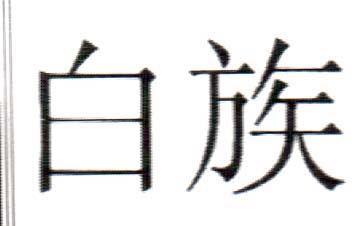
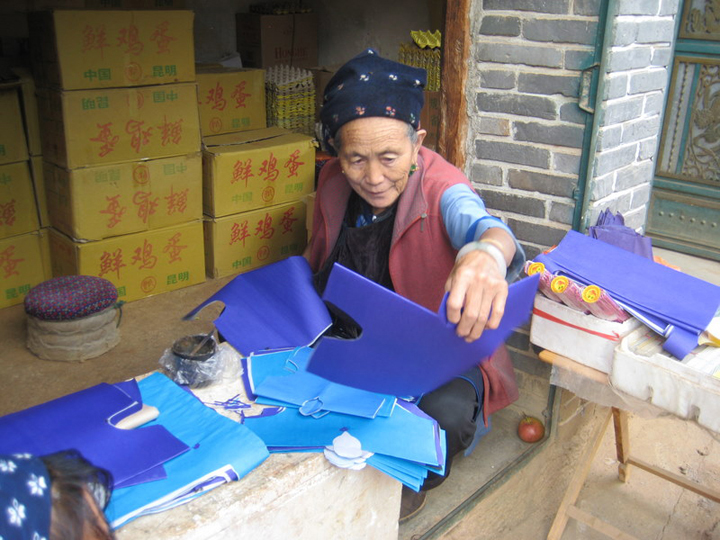 By the 7th century, the ethnic Bai minority people established a powerful kingdom called Nanzhao. Initially, strong and independent, they dominate trade routes and at one point unite with Han the Chinese against the Tibetans until the 8th century. Later, in the 10th century, they themselves are replaced by the Kingdom of Dali. In the middle of the 13th century, China, united by Mongols under the Yuan Dynasty and known as the Menggu, or Mongol Dynasty, are taken over by the Ming Dynasty in the year 1368 CE. In 1644 CE, the Manchu or Manzhou take them over, and in 1911 CE, the People's Republic of China takes over all of them begins their own rule. All of these dynasties incorporate the Bai and other ethnic minorities, but it is not until the People's Republic that they gain some stature and some importance. This is in the mid 1950's.
By the 7th century, the ethnic Bai minority people established a powerful kingdom called Nanzhao. Initially, strong and independent, they dominate trade routes and at one point unite with Han the Chinese against the Tibetans until the 8th century. Later, in the 10th century, they themselves are replaced by the Kingdom of Dali. In the middle of the 13th century, China, united by Mongols under the Yuan Dynasty and known as the Menggu, or Mongol Dynasty, are taken over by the Ming Dynasty in the year 1368 CE. In 1644 CE, the Manchu or Manzhou take them over, and in 1911 CE, the People's Republic of China takes over all of them begins their own rule. All of these dynasties incorporate the Bai and other ethnic minorities, but it is not until the People's Republic that they gain some stature and some importance. This is in the mid 1950's.
During the above times, the Bai population continues to grow. It is now almost two million strong. Most Bai live in the southwestern corner of the Yunnan Province, a place with a population of forty-two million. Some live elsewhere in the province as do twenty-three other minority groups and the Han. They also live in Dali Bai, Nujiang Lisu, Degen Tibetan, and Chuxiong Yi Autonomous Prefectures, the Bai-Primi Autonomous County of Lanping, and in the ancient cities of Dali and newer Dali, better one known as Xiaguan. There are also some seventy-five thousand Bai living in Yunnan's capital city of Kunming, and smaller numbers of them in neighboring provinces of Sichuan, Guizhou, and Hunan.
The name Bai or Baizu became their official name in 1956. Before that, Chinese knew them as Minjia or commoners. They call themselves Baiwazi, Baizi, Baini, Bairen, and some sixty other names. If you know them as Boren or Pusu, it may be because you know about them from Chinese and Western writings before the Christian era.
Most Bai practice Buddhism or Taoism and most speak Chinese and their own language, one belonging to the Yi branch of the Tibetan-Burmese ethno-linguistic group of the Sino-Tibetan language family. Bai people never had a written language until 1949. Thanks to efforts of the Chinese government, they now write in what has become their language that uses the Latin alphabet. Chinese experts say their language uses many Chinese words. Everyone says they are the most assimilated of any minority population because of long-term close contact with the Han population. In Chinese, bai means white; in their language it does too. To them, it represents high social status and dignity.
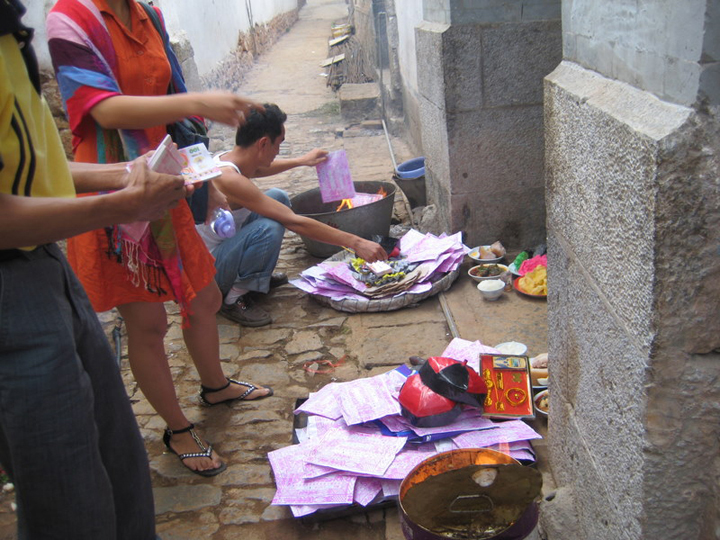
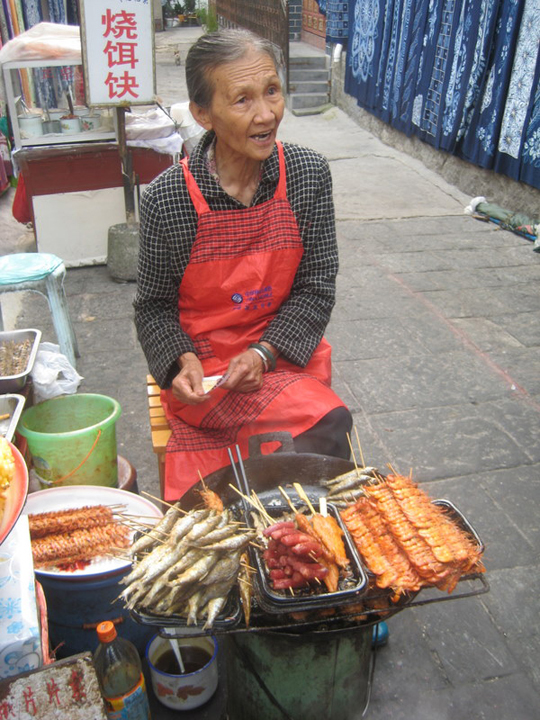 Bai men used to wear white shirts, sometimes white pants. Their women donned white, pink, or light blue long-sleeve blouses and an embroidered vest-like top over the blouse. They wore a red scarf or sash over that, and an embroidered hat with white streamers on their heads. Now, Bai men and women wear these native outfits only on holidays and at festivities. They are particularly proud of those made with tonghua cloth that have bright colored accents and delicate embroidery.
Bai men used to wear white shirts, sometimes white pants. Their women donned white, pink, or light blue long-sleeve blouses and an embroidered vest-like top over the blouse. They wore a red scarf or sash over that, and an embroidered hat with white streamers on their heads. Now, Bai men and women wear these native outfits only on holidays and at festivities. They are particularly proud of those made with tonghua cloth that have bright colored accents and delicate embroidery.
Developed during Nanzhao times when they were part of the Dali Kingdom, their hand-embroidered hats can have camellia flowers, said to be symbols of beauty. Beside doing fine embroidery, women design dark blue tie-dye fabrics using various techniques, some with dyes made from herbs. In the picture on this page, note the woman sitting and selling typical Bai snacks on skewers. Others not seen here are hanging for sale are on a local street in a Bai village.
Not too long ago, Bai people kept quiet about their ethnicity. No longer. Since the middle of the 20th century, most reclaim their ethnic roots, want to have two children, and the want other minority perks. The Bai population in Yunnan is growing rapidly; it is the second largest after the Yi people whose population is twice that of the Bai. Early Bai homes indicate this population is probably descended from Ji people, and that was two thousand or more years ago. Some historians report their ancestors as Heman, some say they are Kunming, and others refer to them as Songwaiman. No matter their names, their early houses were made of stone, their newer ones made of brick.
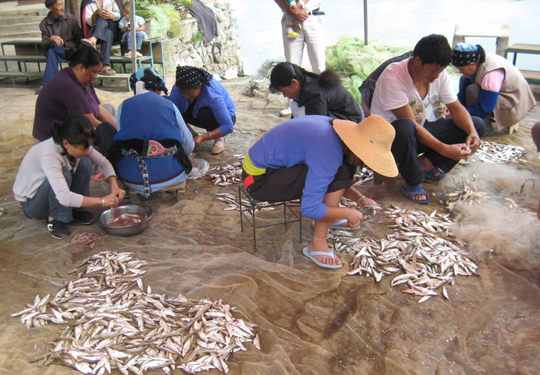 Years ago lots of Bai lived in substantial homes as many of them earned considerable income mining salt in the Nuodong settlement. That ceased when these mines were closed. We can substantiate lots about their early heritage from things uncovered at Haimenkou in Jianchuan. Recently, additional relics located along the Southwestern Silk Road came from Western Han Dynasty times (206 BCE - 24 CE) times. Objects from later digs, circa 1240 to 1060 BCE, indicate the Bai lived in Yunnan in what we call their Bronze Age.
Years ago lots of Bai lived in substantial homes as many of them earned considerable income mining salt in the Nuodong settlement. That ceased when these mines were closed. We can substantiate lots about their early heritage from things uncovered at Haimenkou in Jianchuan. Recently, additional relics located along the Southwestern Silk Road came from Western Han Dynasty times (206 BCE - 24 CE) times. Objects from later digs, circa 1240 to 1060 BCE, indicate the Bai lived in Yunnan in what we call their Bronze Age.
Then and now, Bai are known for their different foods and different festivals. There are some thirty to forty of the latter every year. At many, they burn offerings of clothes, money, food, and other things deemed necessary in the afterlife. And in a Bai village on a festival day, one sees elderly ladies making paper offerings of the clothes to send to their relatives in heaven. We are told the Bai have the largest number of festivals of any minority group. Many are religious such as Buddha's Birthday, Sakyamuni's Festival, etc. Their most important holiday is the March Fair, also known as the Guanyin Fair. It is in the third lunar month, usually in mid-March, and sometimes called the Third Month Fair.
This annual event began in early years of the Tang Dynasty (618 - 907 CE). Now, it is a prosperous commercial bazaar where tens of thousands come to see, participate, buy, and sell things. They also come to savor the many Bai foods for sale.
Bai have many places of worship, the Xingjiao Buddhist Temple is their largest and best preserved one It is from the Ming Dynasty (1368 - 1644 CE) and has thirty wooden statues set in a semi-circle. Buddhists from all over the world come to see it and worship there, particularly during the Pilgrimage and Song Festival in the seventh lunar month. On its first day, it is not uncommon for more than one hundred thousand to gather on Shibao Mountain singing and celebrating. While there, the like to gather herbal medicinals and mushrooms. Others celebrate at the foot of the Cangshan Mountain west of the city of Dali. The holidays are opportunities for dancing, horse racing, meeting suitors, and other events. An important one is the Torch Festival. It ushers in a good harvest and a time to bless people with good health and good fortune. Bai and other minorities celebrate this holiday during the sixth lunar month when they enact a 'planting of the sun' ritual. Young mothers with infants on their backs walk three times around a large torch and pray for their children’s health.
Other festivals include but are not limited to the March Fair, Yu Tan, Tomb Sweeping Day, and the Rice-glue-ball Festival. Most are popular trading days. People of many nationalities come to them, too. They all gather or purchase medicinal herbs, participate in races and song fests, mingle, celebrate, and eat local foods. Butterfly Spring Day is another holiday with flowers on some trees; they look like butterflies flapping their wings. On this day, Bai like to hang real butterflies from many treetops.
Bai not only love festivals, they love eating sour foods, spicy foods, and cold foods. Many congregate at or near Erhai Lake or in the Dali Bai Autonomous Prefecture to enjoy eating fish and meat, rice, corn, and buckwheat plain or with many seasonings. Another favorite Bai food is almost raw meat mixed with piquant seasonings. It is actually baked a very short time but looks quite raw. They also like fried cakes, particularly those made with loofah which is a silk squash, and they like piquant fried sea foods with sour sauce, and many snacks. Do note the women shown on this page selling them along a village street.
Many Bai scenic spots and historical places are worth visiting as are their fertile fields of rice, winter wheat, corn, buckwheat, beans, millet, rape, sugar cane, cotton, and tobacco. So is hiking in nearby forests gathering herbs as they do for cooking and medicinal purposes. We did not get to see how they raise their animals or how they fish, but did see lots of hemp and tea growing, and young women tending bees for their honey.
Bai food and clothing varies from one area to another more so than their food. Pork is their main meat, and lots of dishes are served with flour sauce, seaweed sauce, even lobster sauce. We taste many of them including smoked pork sausage, smoked liver, and smoked intestines, and learn the first cup of tea they serve assures fine aroma, the second is for taste, and the third is to quench thirst.
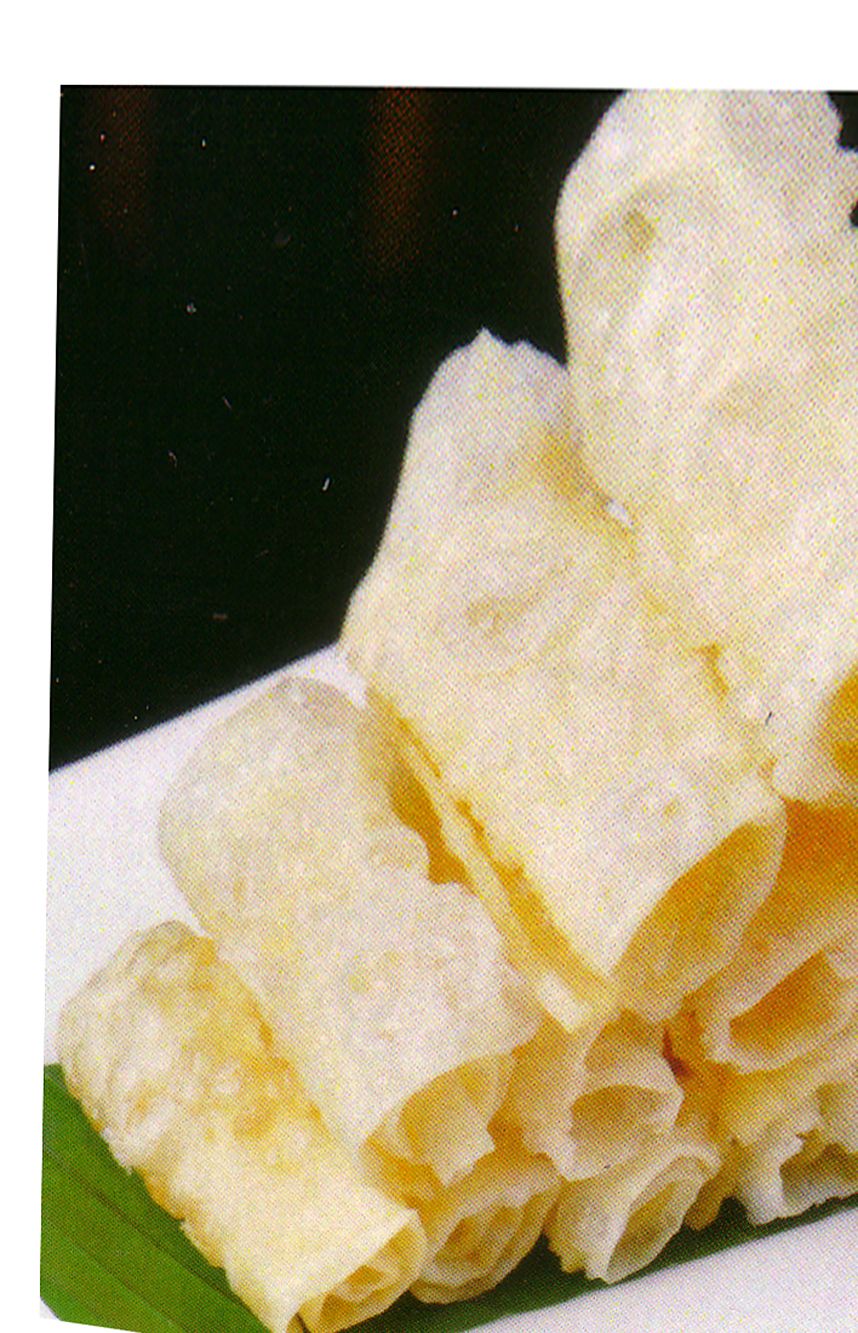 A favorite Bai soup is made with beef and shallots, radishes, and fresh or pickled turnips. We have some at a Bai home with fried potatoes and a green vegetable. Their Milk Fans, called dengchuan rushan, are thin and pancake-like. They can be milky white or milky yellow, rolled and eaten plain or stuffed with minced fish or minced meat and minced pickled vegetables. A family we visit tells us they like theirs fried, str-fried, braised, or boiled, and often with winter mushrooms, pea sprouts, and chicken. They used milk fans in Three-delicacy Fan Shreds stuffed them with chicken, cured ham, and/or with vegetables. By the way, they are called 'shreds' but are more pancake than strip.
A favorite Bai soup is made with beef and shallots, radishes, and fresh or pickled turnips. We have some at a Bai home with fried potatoes and a green vegetable. Their Milk Fans, called dengchuan rushan, are thin and pancake-like. They can be milky white or milky yellow, rolled and eaten plain or stuffed with minced fish or minced meat and minced pickled vegetables. A family we visit tells us they like theirs fried, str-fried, braised, or boiled, and often with winter mushrooms, pea sprouts, and chicken. They used milk fans in Three-delicacy Fan Shreds stuffed them with chicken, cured ham, and/or with vegetables. By the way, they are called 'shreds' but are more pancake than strip.
Bai are hospitable and like to serve guests tea and what they call 'eight bowls; and these are different dishes, and 'three plates' and these are fruits. They like to and did take us to their market which in some towns is on Fridays, in others every five days. They also like to show off their children, particularly in the second lunar month on a holiday called Festival Enhancing Children's Appetites. On this day, they also show off their oxen and feed both of them very special foods.
Bai bake tea leaves before brewing them and serve them three times to a guest, each in a different way. First it is a strong cup, the second a sweet one, and the third cup is a mint version. They like to take tea after getting up and call that 'waking tea.' They like tea again about noon and call it 'relaxing tea.' This noon-hour tea often includes popcorn and/or milk. Rarely do they have tea later in the day, that is, unless they have guests.
There is a tea ceremony called 'Sandao' which is served for guests. The put large tea leaves in a small teapot placed over a charcoal fire. They shake the teapot several times to keep the tea leaves from burning, and when it gives off a strong aroma, boiling water is added. That makes loud noises and so this tea is called 'thunderous tea' and when the noise stops, they pour it for their guests.
Bai like to serve guests a 'Three Delicacy Dish.' It is often red, green, and white, and it is delicious. These days they also say this dish is nutritious and refreshing. Its red color is for the cured ham, green is its added vegetables, and white is the milk fan. This dish used to include a carp from Erhai Lake, but when we were there, fishing was not allowed as there was need to replenish Crucian carp or any fin fish, taking fish from the lake. One lady told us those for sale were from Lake Jianhu, near Shibao Mountain.
Erhai lake fish are mostly Schizothorax taliensis, or Crucian carp. Locals like it minced, seasoned, rolled into their beloved milk fans, then steamed or fried. Other special Bai dishes include Boiled Crucian Carp eaten either in a sour soup or a spicy sauce with or without local broad bean leaves, broad beans, and cubes of preserved ham.
For those who want to learn more about the Bai, we recommend two books and one article for starters. They are Francis Hsu's Under the Ancestor's Shadow written in 1967; and CP Fitzgerald's Tower of Five Glories published in 1941. There is a fine article, David Wu's: Chinese Minority Policy and the Meanings of Minority Culture: The Example of Bai in Yunnan, China. It was published in Human Organization's, Volume 49(1) in the Spring 1990 issue.
Now for general information about some Bai foods, and a few specific recipes:
PICKLED FISH is adored and the sour they crave. They also like pickled vegetables, and pickle them separately in earthenware containers. To prepare the fish, they scale and gut it, then add salt along with Sichuan peppercorns, some fried rice flour, and a dash of rice wine. They eat some cold, cook some usually steaming it, sometimes they braise it. Another way is to prepare some in an unused earthenware pot. In it, they mix all kinds of fish and sea food, particularly sea cucumbers, squid, and carp, then steam or braise them and serve them these foods straight from that earthenware pot. After this dish is cooked, it is popular to mix in some cold pickled fish. That reduces the temperature making it tepid, neither hot nor cold.
FISH IN EARTHEN POT is popular in Dali where it includes sea cucumber, squid, fish, and some pork. In the past it included leftover dishes but now it is only made with salted pickled carp, doufu, carrots, cabbage, and small amounts of sea cucumber and squid. The fish is always cooked before mixing it with the other ingredients; and this dish is always served cold.
FRIED ER KUAI is eaten for breakfast or for snack, or it can be sliced when cold and stir-fried into a hot dish. Most often made with cooked rice or glutinous rice pounded and put into a round form, it is dried, fried, and cooled. In the morning when reheated, it is stuffed after spreading mashed red bean curd and other seasoning pastes on it, then a fried cruller called a yao tiao is folded in half and put on the rice pancake and it is rolled and eaten. A hard-cooked egg can be cut in half and put in with the yao tiao. We see many people eating theirs on the way to work, we find a table and sit to eat ours. The cooked rice can made from white or purple rice, we enjoy the one the lady seen on page 37 is making for us.
COLD RAW MEAT is made with minced or shredded pork, minced fresh ginger and onions, and some vinegar. Small amounts are picked up with the fingers or a piece of er kuai, then popped into the mouth. A substitute for pork can be raw minced snails mixed with pickled cabbage and boiled, stir-fried, marinated, or pickled mushrooms. One lady told us these are raw mushrooms, we believe they pickled and not really raw.
| Three Delicacies |
|---|
1/2 cup meat, beef, chicken, duck, ham, or another 3 Tablespoons cooked bamboo shoots 3 Tablespoons reconstituted dried mushrooms 2 eggs, beaten 2 teaspoons minced onions 1 teaspoon minced fresh ginger 1/2 teaspoon coarse salt 1/4 teaspoon ground white pepper 1/4 teaspoon ground Sichuan peppercorns 1 Tablespoon minced fresh coriander 10 freshly made milk fan rolls 1 teaspoon cornstarch mixed with a half teaspoon cold water 1/2 teaspoon sesame oil (optional) 1 cup vegetable oil Preparation: 1. Cut meat, bamboo shoots, and mushrooms into two-inch slivers, and mix these with the beaten eggs. 2. Add the minced onions and minced fresh ginger, and salt, pepper, peppercorns, and the coriander. 3. Brush the milk fan rolls with the cornstarch mixture making sure the cornstarch mixture is on one end and no meat mixture is on this end. Then spread one-tenth of the meat mixture evenly but not on the end with only cornstarch mixture and roll them up sealing them with the cornstarch mixture. 4. Heat the oil in a wok or a deep pot, and fry half the stuffed rolls until golden yellow, then drain on paper towels. Fry the other half and do likewise. After they are well-drained, serve. |
| Fish On Greens |
|---|
1 pound boneless fish filets, carp preferred 1 cup Chinese black mushrooms or any other single or a mix of dried mushrooms, soaked in warm water for half an hour 1 pound hearts of rape 1 cup chicken or vegetable stock 3 Tablespoons Shaoxing wine salt and pepper, to taste 1 Tablespoon leek- or chili-flavored oil 1 egg and 1 egg yolk, beaten together Preparation: 1. Cut fish filets and mushrooms into one-inch strips and put them into a bowl alternating their pieces; and put rape hearts on top of these slices. 2. Mix stock, salt and pepper, oil, and the beaten eggs and pour over the vegetable, mushroom, and fish mixture being careful not to dislodge the pattern. 3. Cover the bowl with a plate and put into a steamer over rapidly boiling water and steam this for forty minutes. 4. Remove from the steamer and remove the plate. Carefully using a spatula, go around the edge of the bowl, then put a serving plate on the bowl and invert. Then serve. |
| Six Item Squares |
|---|
1 cup Crucian or another pickled carp or white-fleshed fish skin from the above or from another fish 2 egg whites. Beaten only until beginning to foam 1 cup minced shrimp, peels and veins removed 1/2 cup minced water chestnuts 1/2 cup minced rape or another green vegetable 1/2 cup minced smoked ham 1/2 cup chopped walnuts 2 Tablespoons cornstarch 1 Tablespoon white or purple rice flour 1 cup vegetable oil Preparation: 1. Spread the minced fish on the fish skin and spread about one-quarter of the egg white on it. 2. Mix one quarter of the egg white with the minced shrimp and spread this carefully on to the minced fish. 3. Mix the minced water chestnuts and the rape with another quarter of the egg white and spread this carefully on top of the shrimp mixture. 4. Mix the last quarter of the egg white with the minced ham, walnuts, cornstarch, and the wheat flour and spread this on top of the water chestnut-rape layer. 5. Heat the oil in a wok or large deep fry pan and carefully slide this fish package, skin side down, into the oil using two spatulas. With a ladle, pour hot oil from the wok or pan over the fish package until it is golden, about four or five minutes. Then carefully remove it on to three or more paper towels to drain. After one minute, slide it off the paper towel and on to a cutting board. Cut into squares, transfer to a pre-heated platter, and serve. |
| Stuffed Shrimp |
|---|
20 jumbo shrimp, peeled 1/2 cup small peeled shrimp, veins removed, then minced 1/2 cup minced crabmeat 1/4 cup minced belly pork 3 Tablespoons minced water chestnuts 1 Tablespoon peeled minced fresh ginger 1 scallion, minced 2 Tablespoons minced fresh coriander 2 Tablespoons thin soy sauce 3 Tablespoons sesame oil 1/2 teaspoon ground white pepper 3 Tablespoons cornstarch 1 teaspoon granulated chicken bouillon powder 2 eggs, beaten 1/2 cup commercial bread crumbs 1/2 cup panko which are coarse Japanese bread crumbs 1 cup vegetable oil 3 Tablespoons hot sauce mixed with two tablespoons of black vinegar Preparation: 1. Slit the ten shrimp partway down the vein side of each, remove and discard the veins, put layer of plastic wrap on top and lightly pound to flatten them somewhat. 2. Gently mix the minced shrimp, crabmeat, belly pork, water chestnuts, ginger, scallion, and the coriander; then add the soy sauce, sesame oil, ground pepper, cornstarch, and the bouillon powder and spread this stuffing mixture on one side of the cut open shrimp, then top with the other side of the cut open shrimp. 3. Put eggs in one bowl, a mixture of bread crumbs and panko in another, and carefully put each stuffed shrimp into the beaten egg, then into the crumb mixture. Repeat once again into each mixture if they are not well covered, then set aside on a fresh sheet of plastic wrap to air dry for about three-quarters of an hour. 4. Heat oil in a medium-size pot, and deep-fry about five or six minutes until shrimp are cooked through and golden in color. 5. Serve with hot sauce dipping mixture on the side. |
| Silk Squash Pancake Cubes |
|---|
1 large silk squash, about half to three-quarters of a pound, peeled and shredded 3 Tablespoons sweet potato starch 1 Tablespoon cornstarch 2 eggs, beaten 2 Tablespoons vegetable oil, separated 2 Tablespoons crushed Chinese brown sugar 1/4 cup stir-fried scallions Preparation: 1. Mix shredded silk squash with potato starch, corn starch, and the beaten eggs, then add one-quarter cup cold water, and stir well. Let this rest for twenty minutes. 2. Heat wok, add half the vegetable oil, then put in half the silk squash mixture, and flatten to about half-inch, and fry until golden, turning if necessary, then drain on paper towels while frying the other half in the rest of the oil. 3. Cut fried pancakes into one-to-two-inch cubes and serve with dipping sauce on the side. |
| Mushroom Soy Sauce |
|---|
20 to 24 large black mushrooms, soaked in three cups warm water overnight 3 Tablespoons coarse salt 1 cup thin soy sauce, optional 2 small bottles, sterilized Preparation: 1. Drain mushrooms reserving the water; strain if sandy and discard the sand. Then, cut away and discard the mushroom stems. 2. Mix mushrooms and salt and let stand for one to two days. Then mash well with the back of a heavy spoon, liquefying as much as possible. Strain and discard solids or reserve them to add to a soup or an omelet. 3. Bring remaining liquid, reserved mushroom water, and the optional soy sauce to the boil, strain if any solids remain, then pour into two sterilized bottles. Refrigerate and use as needed as you would soy sauce. |
| Sour Chinese Cabbage, Bai Style |
|---|
1 medium-size head of cabbage, napa preferred 3 Tablespoons vegetable oil 6 cloves garlic, peeled; slice three and mash the other three cloves 3 Tablespoons Chinese black vinegar 1/2 teaspoon coarse salt 2 Tablespoons cornstarch mixed with one tablespoon cold water or the soy-type mushroom sauce Preparation: 1. Cut the cabbage in half the long way, then slice crosswise into very thin strips. 2. Heat wok or fr pan, add the oil and stir-fry the garlic slices for half minute, then add the cabbage and stir-fry for two minutes, then add the vinegar and the salt, and the mashed garlic and stir-fry another minute. 3. Stir in the well-mixed cornstarch/water mix and stir until it thickens and cats the cabbage. Then serve. |

Copyright © 1994-2025 by ISACC, all rights reserved
Address
3 Jefferson Ferry Drive
S. Setauket NY 11720